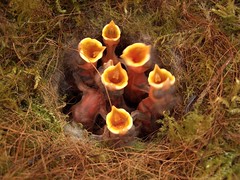
Three researchers from the University of Granada have questioned the long-standing assumption that investigator presence negatively impacts breeding success.
Juan D. Ibáñez-Álamo, Olivia Sanllorente, and Manual Soler conducted a meta-analysis on 18 studies of investigator impact on natural nests. Of the 101 papers they found on this subject, only these 18 were experimental and met the criteria for the meta-analysis. Even with current technology such as remote cameras, it would be difficult, if not impossible, to study breeding success without any investigator presence, but this meta-analysis considered observations through binoculars to be the equivalent of a non-visit. In addition, this meta-analysis used the extent of disturbance as the measure of the impact of investigator presence. When a causal relationship exists, there should be an exposure-response such that increased exposure produces an increased response. Therefore, if investigator presence affects breeding success, increased presence should have greater impact than does less frequent presence or presence of shorter duration.
The meta-analysis looked at the extent of the impact by as reflected by the number of depredated and successful nests under a high perturbation treatment vs. low perturbation and non-perturbation treatments, habitat type, and the study methods (frequency of visits, visit v. non-visit, touched vs. untouched).

The depression of predation rates was not found in studies measuring visit vs. non-visit, perhaps because even with binoculars, the researcher is still physically present at a distance close enough to assess breeding success, which is still relatively close to the nest.
The negative effect on nest predation was strong enough that the authors caution those studying nest predation rates to take into account the impact of their own presence on the results.
This article summarizes information in this publication:
Ibáñez-Álamo, Juan D., Olivia Sanllorente, and Manual Soler. 2011. The impact of researcher disturbance on nest predation rates: a meta-analysis. Ibis (pre-publication version first published online on 7 November 2011).
http://ornithologyexchange.org/files/file/7-%7B%3F%7D/
Photo credits:
Black rat snake predation event by @Andrew Cox.
Great Tit nestling by jamesmorton on Flickr, used here under license CC BY-NC-ND 2.0.



Recommended Comments
There are no comments to display.
Join the conversation
You can post now and register later. If you have an account, sign in now to post with your account.
Note: Your post will require moderator approval before it will be visible.